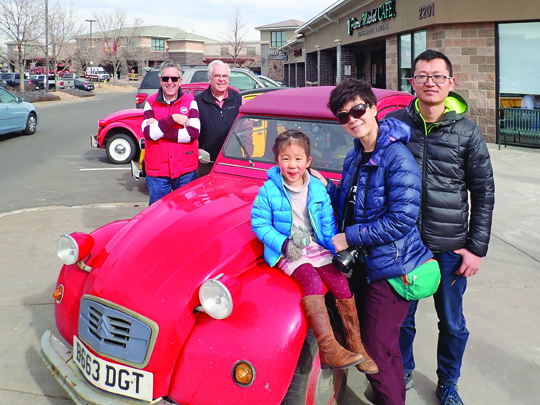
by Mark Smiley | Mar 1, 2018 | Travel
by Lisa Marlin

Around The World: At the Pierre Michel French Cafe in Littleton, Camilo Salazar, left, and Gary Daniels, met up with Jie Ding, Chang Luo, and their daughter Yuding who are traveling around the world in their 1985 Citroën 2CV.
England. Russia. China. Colorado. Nine months into their two-year road trip, the Luo Family has traveled to all these places with their primary mode of transportation being a red 1985 Citroën 2CV. This small, no-frills French car was produced from the late 1940s to 1990 and still garners interest worldwide.
A group of Denver-area Citroën enthusiasts greeted Chang Luo, wife Jie Ding, both 38, and their four-year-old daughter Yuding, when the family stopped for lunch at a French café in Littleton on January 31. They’d recently journeyed to the Arctic Circle and were driving south through the Americas.
“It’s just life on the road,” said Ding, after unbuckling Yuding from a car seat in the back where their luggage is also stacked. “Chang enjoys cars so much and I enjoy traveling and meeting people so much and this car just combines our interests, so we enjoy it.”
This is not their first road trip. In 2011, Luo got the job of an automobile engineer in London. Before moving there, he and Ding carefully studied the feasibility of driving from their home in Shanghai to his new job in London along the ancient Silk Road and decided to do it. Five years later he bought and restored the Citroën, then he quit his job so he and Ding could take their young daughter on an even longer road trip before she starts school. Why travel in a 33-year-old car? “This car is very interesting. I put a lot of effort into it. It has to be this car,” he said.
Ding said the experience enriches their family time. “For two years we can spend 24 hours a day together, to plan together, to see things together. I think that’s really important and we appreciate that we have this time to do that,” she said.
The first leg of their trip began in April 2017 when they left England and drove through 19 countries on their way to China to visit family and friends. From there, they shipped the car to Vancouver, British Columbia.
“I do almost all the driving,” Luo said. “And the car needs attention from time to time, maintenance, servicing, and I do it all myself.” This seemed to be especially true in Colorado. “The elevation of Colorado is phenomenal, and the car feels it. The power has lost quite a few horses I would say, and the start can be quite tricky.”
He lifted the hood as the local Citroën enthusiasts gathered to peer inside and talk with him about the engine. Among them was Camilo Salazar who has owned several of the cars and keeps in contact with other owners around the world; that’s how he heard about the Luos’ trip and began emailing with them to help coordinate their trip through Colorado.
“The Citroën has the most impressive suspension in automobiles ever,” Salazar said, which makes it great for long distance trips. He said it’s also very simple to work on. “It’s basically a glorified lawnmower,” he said, which makes it louder than most cars and slower, topping out at 70 miles per hour.
Denverite Gary Daniels drove his Citroën across town to meet the Luos. It’s one of several he’s owned over the years. “Everybody has an interest in the car. You just have to ride in one,” Daniels said. “It’s so very versatile.”
Versatility can be important when traveling around the world in a car. Even though the Luos have a general plan to reach Argentina in a year, they’re not following a
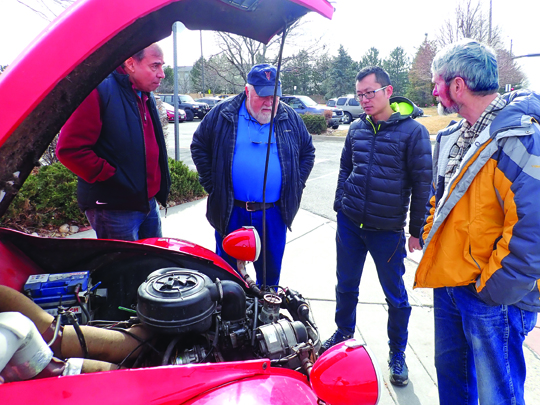
Under The Hood: The Citroën is an air-cooled front-engine, front-wheel-drive economy car introduced at the 1948 Paris Mondial de Automobile and manufactured by Citroën for model years 1948-1990. In total, Citroën manufactured almost 9 million 2CVs and variants.
direct route by any means. After leaving Denver, they drove up Pike’s Peak, which was on their must-visit list in Colorado, but then changed their plans to head south from there, and instead ventured toward Montreal to celebrate the Chinese New Year with friends. On February 20, they sent word that they would be going to New York before traveling toward southern California where they’ll cross the border into Mexico. Wherever they go, they mostly stay in the homes of families they meet along the way or that they find through hospitality and networking services such as CouchSurfing.
Ding is blogging, in Chinese, about their adventure so their family and friends back home can keep up. “We have lots of stories to share with our followers to tell them what is going on in other countries. The normal family, what do they do?” she said. “Meeting car club friends has been the best part of our trip, we have been so surprised to see there are still quite a lot of Citroën fans in North America.”
After having lunch in the French café with their new Colorado friends, the family loaded back into their Citroën, buckling Yuding in her car seat. Luo said his daughter is coping very well with her new lifestyle. “She entertains herself in the car by drawing, singing, looking around, especially when we were in the north, in Alaska and northern Canada where there were many wild animals. That was a lot of fun.”
In a blink, they were off again, wide-eyed and heading down the highway in their bright red Citroën, adventure bound.

by Mark Smiley | Jan 29, 2018 | Travel
Have A Dog-Gone-Good Time At Chinese Bark In The Park Party
Bowwow The Night Away At Chinese New Year Gala
With Your Puppy Love, Pampered Pals At McNichols Feb. 9
One of the most internationally celebrated events of the year, the Cherry Creek Valley’s Chinese New Year Celebration hosted by the Nathan Yip Foundation has become one of the biggest and best in the nation. This year’s event commemorates the Year of the Dog — the 11th in the 12-year cycle of Chinese zodiac
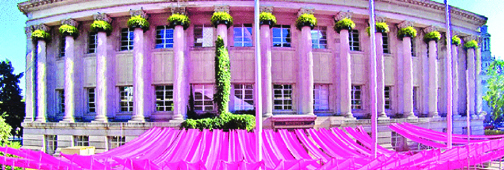
Party Palace: The Cherry Creek Valley’s Chinese New Year Celebration is in the McNichols Bldg. on the northwest corner of Civic Center Park, Feb. 9, 6 p.m.
sign events — in the McNichols Bldg. on the northwest corner of Civic Center Park, Feb. 9, 6 p.m.
No bones about it, attendees will get caught up in the energy as they chase after their dreams in the Valley’s first and original Chinese party. Now in its 15th year, it is one of the biggest of its kind outside of China. Spread over three floors of the McNichols Party Palace, the multitude will have a “dog-gone-good time” enjoying food, interactive entertainment, plus an authentic Chinese Night Market.
All proceeds from the evening will benefit the Foundation’s funding of educational projects for the most vulnerable children in rural Colorado and China. Last year’s Chinese New Year Party raised more than $250,000. The Foundation is named for the son of Denver residents and founders Linda and Jimmy Yip. The Yips lost their only son Nathan in a 2002 car accident. For years the Yips, with a team of volunteers and friends, built schools and provided supplies to rural, forgotten areas in China. Now they are putting that same effort into rural Colorado communities.
Run With Big Dogs
Dog is man’s good friend who can understand the human’s spirit and obey its master, whether he is wealthy or not. The Chinese regard it as an auspicious animal. If a dog happens to come to a house, it symbolizes th

Chinese Characters: Attendees at Nathan Yip Foundation Chinese New Year Celebration will meet colorful characters at party Feb. 9. Now in its 15th year, it is one of the biggest events of its kind outside of China.
e coming of fortune. The invincible God Erlang in Chinese legend used a loyal wolfhound to help him capture monsters.
According to Lunar New Year pros, the Year of the Dog will be a good year for action and should offer new business opportunities and, furthermore, is conducive to festivals, especially fundraisers such as the Nathan Yip Foundation celebration.
Guests will run with the big dogs at this year’s canine carnival featuring world-class performers including lion dancers, a karaoke stage, silent disco, fortune teller, Chinese calligraphers and portrait artists. More: This year guests will also be blessed watching the “im’paws’ible” as dogs entertain. Acro Dogs — good doggies performing for this good year — are an added attraction. It’s the Year of the Dog after all, and you’ll discover dogs have talents ranging from Yoga and Irish dancing to painting and more.
Indoor Street Party

Tree Of Luck: According to Lunar New Year pros, the Year of the Dog will be a good year for action and should offer new business opportunities.

East Meets West: The biggest and most colorful celebration in the East is now one of Denver’s biggest party events. The Nathan Yip Foundation celebration provides funding for educational projects for the most vulnerable children in Colorado and China.

Dog-Day Night: This year’s event commemorates the Year of the Dog, the 11th in the 12-year cycle of Chinese zodiac sign events.

Night Market: Spread over three floors, attendees will have a “dog-gone-good time” enjoying food, interactive entertainment, plus an authentic Chinese Night Market.
This year’s colorful celebration is getting an exciting twist of the dog’s tail: The festive, fun-filled Chinese-themed Night Market has been expanded. It’s a new-fangled version of a street party complete with troupes of acrobats, Chinese lion dancers, and of course tasty themed food stations. It features fabulous foods, thrilling lion dances, and shock-red lanterns.
In addition to themed food stations and full open bars, the Indoor Night Market offers fun wares for sale, just like travelers see throughout Asia.
The delicious and diverse tasting stations will feature food prepared by Denver’s Catering by Design. The Seattle Fish Company is sponsoring the marketplace. The company’s CEO James Iain went to school with Nathan Yip.
Helping At Home
Because the annual event celebrates Chinese New Year, many people think all of the Foundation’s work is still in China. However, as the world has changed, so has the focus of Foundation’s effort.
In the metro area the Foundation continues supporting such groups as the George Washington High School’s Mentoring Program, Patriot Pairs. The Foundation contributes all of the expensive graphing calculators for the all mentees plus finds the most overlooked areas to help. At East High School, Nate’s Pass Program supplements bus passes for students that need transportation to school.
“But the real forgotten areas of Colorado are the rural areas,” according to Board Member Denise Gliwa. There are not many organizations traveling to the far corners of our state and learning and recognizing the educational needs of these students and school districts, she notes. With a “hands on” approach, Jimmy and Linda Yip travel to these areas and really find out their educational needs.
Country School Upgraded
Some of the work the Foundation did during the past year included a Technology Grant to Eads High School to upgrade its science classes so students can actually do experiments. The ventilation in the classroom was so bad students could not do the necessary work.
At San Luis Valley’s Center Consolidated School District the Foundation provided funding for teacher pay so that every teacher could do family Home Visits in the small agricultural community.
The Foundation also urbanized a professional development partnership between the schools in Montezuma-Cortez with the STEM School in Highlands Ranch. The STEM teachers visited Montezuma-Cortez and the MC teachers and admin visited STEM to learn and share ideas.
Providing Computers
A team of volunteers last year traveled to the San Luis Valley and dropped off 40 laptop computers to the San Luis Valley Board of Cooperative Education Services (BOCES). The computers were distributed to students in the area who do not have a computer at home.
Following that, the team delivered another 40 laptop computers to the Ute Mountain Ute Reservation, for the same purposes.
An additional 40 computers were distributed to Colorado’s Eastern Plains plus 18 to Eads. This was done in cooperation with Rose Keating and her organization Tech For All. The decision to provide the computers was made because students without computers at home are at a huge disadvantage when it comes to computer literacy. Information: 303-817-8400.

by Mark Smiley | Dec 17, 2017 | Travel
First National TV Partnership In Domestic Professional Rugby
by Glen Richardson

Nationally Televised: Major League Rugby, which includes the Glendale Raptors, will be broadcast on CBS Sports Network beginning in April 2018. This marks the first national television partnership in the history of American professional rugby.
Major League Rugby (MLR) and CBS Sports Network have announced an exclusive, multi-year television partnership. CBS Sports Network will televise the inaugural season of the new start-up league beginning in April 2018, marking the first national television partnership in the history of American professional rugby.
The Glendale Raptors who call Infinity Park their home were founded in 2007 and now, 11 years later, will be broadcast to all homes carrying the CBS Sports Network. “We are thrilled to announce this partnership,” said Glendale Mayor Mike Dunafon. “The exposure this will give our city is another way we are building upon the vision we had over a decade ago.”
CBS Sports Network will televise a 13-game package with 10 weeks of regular season coverage — highlighted by a Major League Rugby Game of the Week — and two weeks of postseason coverage in 2018, including the semifinals and the first MLR Championship Game.
“We look forward to being the television home of Major League Rugby,” said Dan Weinberg, Executive Vice President of Programming, CBS Sports. “MLR will showcase the speed, power and agility of this exciting sport and we are excited for the launch in April.”
“Partnering with CBS Sports Network is a great step for Major League Rugby and for the sport of rugby in America,” said Major League Rugby Commissioner Dean Howes. “There is no question that rugby is growing fast in the U.S. market. A successful professional league is a critical component of that growth. Television partnerships are incredibly important to any professional league, and we are excited to chart a path to success together with CBS Sports Network.”
Major League Rugby will launch with seven teams in Austin, Houston, Glendale (Colorado), New Orleans, San Diego, Seattle and Salt Lake City (Utah). Each is a key rugby market with a long history of support for the game. The members have strong, local and civic-minded ownership groups with deep ties to their communities and have established grassroots programs, venues in place or in development, and a player pool featuring the best players in North America, reinforced by up to five international signings in the 15-player, Rugby Union format.
For more information on the Glendale Raptors, visit www.glendaleraptors.com. For more information on CBS Sports Network, including a full programming schedule, go to www.cbssportsnetwork.com.
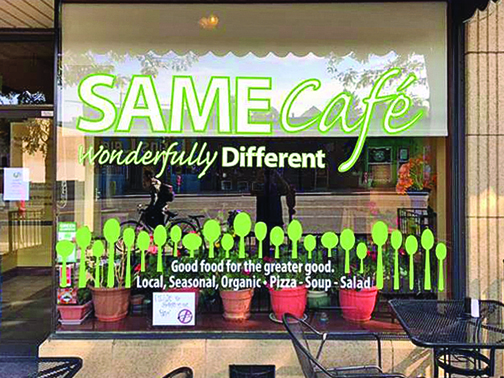
by Mark Smiley | Nov 20, 2017 | Travel
by Ruthy Wexler
 SAME Café’s mission is feeding the hungry. Its name stands for So All May Eat. But the café itself resembles an elegant little bistro, complete with outside dining.
SAME Café’s mission is feeding the hungry. Its name stands for So All May Eat. But the café itself resembles an elegant little bistro, complete with outside dining.
Nothing about SAME Café, at 2023 E. Colfax, says “homeless” or “charity.” That’s the uniqueness of this restaurant, where Cherry Creek residents, suburban folk, busy professionals — and people down on their luck — all get welcomed and well-fed.
Uniquely Different
I’ve ordered lunch, it looks delicious — but I stand confused. No prices listed, no cash register in sight.
How do I pay? I ask.
“You pay what you want,” smiles the girl at the counter.
After devouring the richly flavored soup (homemade vegetable stock, definitely) and relishing my pizza’s contrasting bites of apple, kale and blue cheese, I wonder: How could a “donation based” restaurant serve such exquisite food — and survive?
The answer, says Executive Director Brad Reubendale, is community. “We have the greatest group of volunteers and customers, who are invested in our succes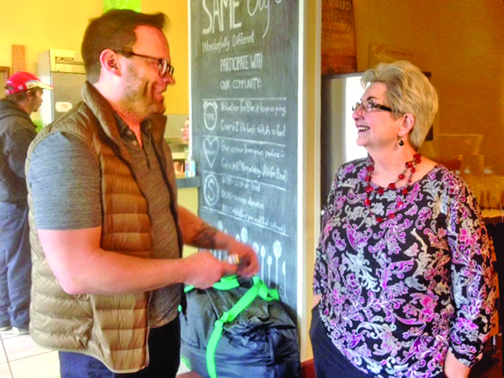 s.”
s.”
More and more groups now use the café for meetings. Increasing numbers book it for private parties and events. The café’s good intentions toward the community have brought win/win results.
Doing Well
Having supported local farmers, the café now receives so much donated produce, they only have to purchase basic food. They support local businesses — and a local businessman, and their landlord sets their rent below market value.
“What I see over and over, if you trust people to be helpful and intelligent, for the most part, they’ll be that way,” says Reubendale. “People on the poverty line pay a dollar for lunch. Others know this and give way more than the meal’s worth”
“We eat here a lot,” says Laura Mueller, lunching with fellow retired physician Danica Larson. “We want to support their mission. And the food is amazing. So healthy!”
Healthy food — where it all started.
History
In 2003, Brad and Libby Birky were at a crossroads. An IT consultant, he yearned to be a chef. But Birky wanted no part of the late-night restaurant lifestyle, so they researched other options. Both had volunteered at soup kitchens, but the disconnect between those who doled out the food and those who ate it didn’t sit right. And the food was not healthy.
What if a soup kitchen served food so good that people with money chose to eat there, too?
There was one such restaurant, they discovered. After visiting One World in Salt Lake City, the Birkys became 100% committed. Banks refused to loan them money so they cashed in their IRAs. The city’s red tape almost botched 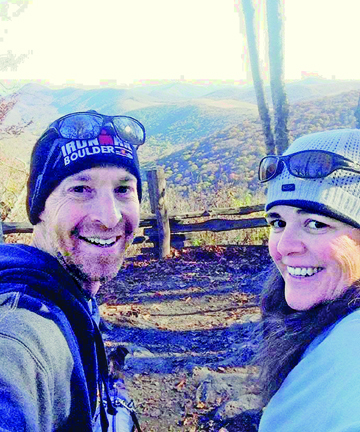 the project. But finally, on October 20, 2006, the SAME Café opened.
the project. But finally, on October 20, 2006, the SAME Café opened.
Something Incredible
The Birkys’ original idea — giving everyone access to good, healthy food — remains the café’s driving force.
People get interested in the café’s mission. They return because of the food. Each day, two kinds of soup, two kinds of salad, two pizzas, and one cookie are offered. Natural-ingredient menus planned by an exuberant chef feature Strawberry Soup, Braised Brisket Stew, Roasted Mushroom and Quinoa Salad.
Tables for two line the walls, but the long table down the café’s center affords an unusual opportunity: eating alongside someone from a very different life. “Something incredible happens when people who have millions sit down next to someone experiencing homelessness,” reports Reubendale.
So Much Change
A volunteer describes when someone who’s been living on the street comes in to eat. “They light up, like, ‘All this nice stuff for me? I’m not looked down upon here?’”
“It’s beautiful. No one brags about money here. No one’s shamed if they don’t have it.”
People living below the poverty line are treated with as much dignity as a wealthy person, says Reubendale. “That’s why we don’t give handouts. If someone wants free food, we say, ‘Here, please eat. Then we ask how they’d like to participate in our community. One hour of work pays for a meal.’
“When someone’s ready, we have a great resource list. A computer they can use to research jobs or housing.”
“So many lives have been changed here,” Reubendale muses. “Not just the hungry. Rich people who needed purpose. Sick people who began eating healthy, then got well…”
People often asked the Birkys how to start a restaurant just like SAME. Now the couple is on a road trip, visiting the 50+ cafés across the country they inspired and mentored.
Talk about change.
Holiday Giving
The café has just created wooden circles that say SAME Café: One Free Lunch.” Think of driving down Speer Boulevard with a bagful of these tokens to give out! Purchasing them provides two good works in one: giving to SAME Café’s mission — and connecting a person in need with a service that could change their lives.
You can buy the tokens with a donation (the café suggests the full price of meals, around $12). Or email brad@soallmayeat.org, who will get the tokens to you.
The SAME Café is open Monday-Saturday, 11 a.m. to 2 p.m. For more information visit www.soallmayeat.org.

by Mark Smiley | Oct 23, 2017 | Travel
60,000 Attend The 36th Annual Event
by Jeff Stiglic and Mark Smiley

The 36th Annual Great American Beer Festival (GABF) was held October 5-7, 2017, at the Colorado Convention Center. Over 800 breweries poured 3,900 beers over the three-day fest hosted by the Brewers Association. Attendees surpassed 60,000 making it the largest attended GABF ever. It has come a long way since 1982 when it was held at the Harvest House Hotel in Boulder. There were 24 breweries, 47 beers and 800 attendees back then.
The state of Colorado won 38 medals as Glendale’s very own Bull & Bush Brewery took home a bronze medal for their Wood- and Barrel-Aged Beer called Woody Pils. Colorado tied their total from last year with an impressive lineup of entries. As an attendee who lives in Denver, it is nice to support the home team but it is also an opportunity to taste beers that are otherwise unavailable in this state. And, it is a chance to sample beers that are just starting distribution in Colorado such as Surly Brewing Company from Minneapolis, Minnesota, and Two Roads Brewing Company from Stratford, Connecticut.
“Having just launched our beers in the Colorado market, it was a great opportunity to gain brand recognition locally,” said Lizzy Shpitalnik, Colorado Sales Manager for Two Roads Brewing Company. “We also had Two Roads staff at the booth pouring our ten offerings at all times, so we were able to connect with festival goers on a deeper level.”
Two Roads was also invited to an event called What the Funk hosted by Crooked Stave Artisans. This event was one of many held outside the confines of the Colorado Convention Center. On Wednesday, October 4, 2017, The Studios at Overland Crossing played host to this year’s event. Attendees were treated to rare beers and adventurous concoctions that served as a great lead in to this year’s GABF.
The crew of Brewski-Reviewski not 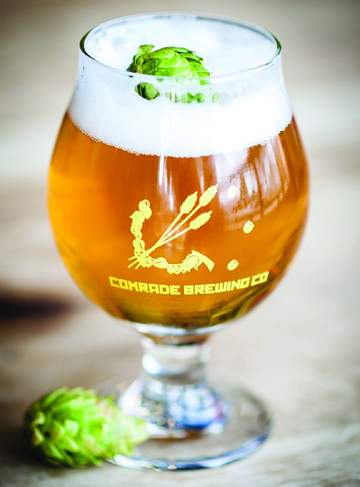 only attended the three day GABF but also covered many of these events in and around town to see how they enhanced the week dedicated to beer.
only attended the three day GABF but also covered many of these events in and around town to see how they enhanced the week dedicated to beer.
Thursday, October 5, opening night of GABF, the crew started the first hour at the festival getting a feel for the layout of the hall so they would be able to easily navigate it on Saturday, October 7, after the awards ceremony. After that, it was off to Epic Brewing for the 5th annual 50 Firkin Fiasco.
The event was set up throughout the brewery with 50 specialty beers they brewed and collaborated with other breweries. Epic did not disappoint on this, with beers scattered everywhere to taste, and live music to set the mood. From standard beers like IPAs and stouts to beers brewed with sage and even one with Swedish Fish, this is a recommended event for next year.
Bierstadt Lagerhaus was the venue for the Beer Hall Brawl with Melvin Brewing from Wyoming. This event could be characterized by one word: crazy. The crew from these two places combined the in-house beer from Bierstadt with Melvin, having Hacksaw Jim Duggan wrestling with the team from Rocky Mountain Pro Wrestlers. The crowd enjoyed the theatrics of the wrestlers with some great German style beers.
Friday morning had two interesting events to choose from. Samuel Adams hosted its annual Brewers Brunch at Marlowe’s off 16th Street Mall. And, Oskar Blues promoted a Friends and Family Backstage Pass and Tour with a bus from Denver to the brewery in Longmont.
The Brewers Brunch organized and hosted by Samuel Adams is a

Sam Adams GABF brunch Friday, Oct. 6, 2017, in Denver. (Photo by Jack Dempsey for Boston Beer Company)
time-honored tradition and a chance for beer enthusiasts to engage in conversations about all things craft beer. Jim Koch, founder of Samuel Adams kicked off the event welcoming the capacity crowd to Denver. Koch started Samuel Adams in his kitchen in 1984 when imported and domestic beers were the only options for beer lovers.
A panel moderated by Bob Pease, President and CEO of the Brewers Association, included Koch and other craft brewers who shared their stories on what makes their breweries successful and the challenges they face.
Samuel Adams capped off the event by introducing its newest beer that will hit the market early next year called Sam ’76. It’s a beer that takes two active fermentations and blends them together with Cascade, Citra, Mosaic, Simcoe and Galaxy hops. It imparts a tropical citrus aroma that gives way to a bright, juicy citrus hop flavor but without the hop bitterness.
Turning to the Oskar Blues event, media and guests were greeted at the Longmont brewery with a pint of Fresh Hop Pale Ale. There were six groups each with 15-18 guests to walk through the brewery with head brewer Tim Matthews.
Part of the tour focused on the actual science that goes into the brewing process. The tour was followed up with a lunch provided by CHUBurger by Oskar Blues while Matthews described what goes into four of their beers: Mamm’s Little Pils, Pinner, Dales Pale Ale, and IPA. All in all, a tour at Oskar Blues is a good experience. They conduct tours every day of the week. Visit www. oskarblues.com for more information.
On Friday afternoon, Avery hosted a guided tasting with brewer Andy Parker at Hayter’s & Co. in LODO. Parker described each of the beers on sample at the ro oftop event while guests sampled them all. It allowed for plenty of time to try many of the beers offered by Avery and make it to the GABF on time.
oftop event while guests sampled them all. It allowed for plenty of time to try many of the beers offered by Avery and make it to the GABF on time.
The Awards Ceremony is the key event for brewers and a big part of why they participate in the festival. It is a chance for smaller breweries to win a medal and be recognized for the hard work they put into their beers. The medal winners were announced on Saturday morning, October 7.
Launch Pad Brewery in Aurora is a small brewery that took home a silver medal for session beers with a beer called Peacekeeper. “It’s a bigger feeling than I thought it would be, and it’s great to be recognized by your peers for your hard work,” said David Levesque, owner of Launch Pad Brewery.
The 37th Annual GABF will once again be held at the Colorado Convention Center but earlier in 2018. It will be held from September 20-22, 2018. Visit www.great americanbeerfestival.com for more details.
To listen to interviews with brewers, visit www.brewski-reviewski.podbean.com.

by Mark Smiley | Sep 25, 2017 | Travel
One Of The Great Public Venues In The Cherry Creek Valley Is CommonGround Golf Course
by Mark Smiley
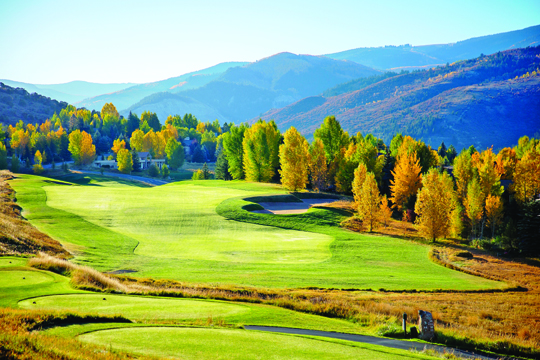 Now that summer is in the rear-view mirror, it is time to winterize the lawn mower, make sure the snow blower starts, and put away the golf clubs. Not so fast on the golf clubs. Autumn is a great time of year to golf. The courses are less crowded, the green fees are less expensive, and the fall colors in Colorado are spectacular.
Now that summer is in the rear-view mirror, it is time to winterize the lawn mower, make sure the snow blower starts, and put away the golf clubs. Not so fast on the golf clubs. Autumn is a great time of year to golf. The courses are less crowded, the green fees are less expensive, and the fall colors in Colorado are spectacular.
The Colorado Golf Association (CGA) has many courses in its directory that feature fall golf. The CGA’s purpose is to represent, promote, and serve the best interests of golf in the state of Colorado, and has been throughout its history. The organization is the official representative of the United States Golf Association (USGA) for the state of Colorado.
The Colorado Golf Association (CGA) was established in August 1915. The CGA’s first official function was to formally take over the administration of the state’s amateur match play championship, which started in 1901. This tournament is still conducted by the Colorado Golf Association, making it the oldest golf tournament in the state of Colorado.
Today, over 43,000 men and 17,000 women are members of the CGA and the Colorado Women’s Golf Association (CWGA). Those that have a handicap are eligible to be members of the CGA or CWGA and those that do not can set one up at a course that is owned by the CGA, CommonGround.
CommonGround, located in Aurora and in proximity to Glendale, is an affordable championship course that opened in 2009 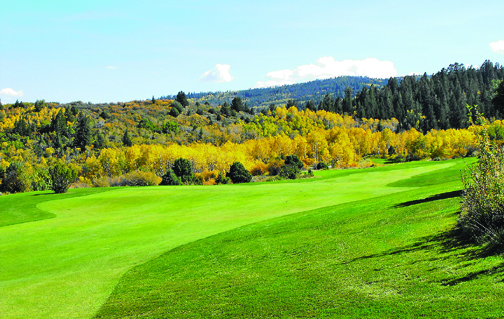 and was designed by world renowned golf course architect Tom Doak. Doak has four courses ranked among the top 100 in the world according to the “Top 100 Courses in the World” list compiled by Golf Magazine. Ballyneal Golf Course in Holyoke, Colorado, is one of those four courses.
and was designed by world renowned golf course architect Tom Doak. Doak has four courses ranked among the top 100 in the world according to the “Top 100 Courses in the World” list compiled by Golf Magazine. Ballyneal Golf Course in Holyoke, Colorado, is one of those four courses.
Members of the CGA get 25 percent off their green fees at CommonGround and becoming a member is $55 annually. In addition to its 18-hole course, CommonGround also features a 9-hole Par 3 course. This is designed for juniors or seniors who want to get a fast game in and practice. CommonGround allows anyone 18 years of age or younger to golf the 9-hole Par 3 course at no cost. Adults are $10.
CommonGround is not only a championship course at an affordable rate but will serve as the stroke play co-host course for the 2019 Mid-Amateur.
Golfing in the fall is often overlooked but the  fact of the matter is that fall has the least precipitation of the non-winter months, has cooler temperatures, and is the most scenic time of the year. “Fall is the most beautiful time of the year in Colorado,” said Aaron Kellough, Director of Communications for the CGA. “If you want to get up in the mountains in late September or early October when the aspens start changing, it’s unbelievable.”
fact of the matter is that fall has the least precipitation of the non-winter months, has cooler temperatures, and is the most scenic time of the year. “Fall is the most beautiful time of the year in Colorado,” said Aaron Kellough, Director of Communications for the CGA. “If you want to get up in the mountains in late September or early October when the aspens start changing, it’s unbelievable.”
Some of the more technical reasons why golf in the fall works well is the ground is harder and drives go further. It gives golfers better chances to score. Courses are also less crowded which can make for a more enjoyable experience.
“This fall is an opportunity to play three courses that you won’t pla y again in the same way,” said Ryan Smith, Director of Development for the CGA. “Now is the time to go see City Park before the new design and for those who love the history and the past, get over to Fitzsimons and get over to Park Hill because the future is changing for them.”
y again in the same way,” said Ryan Smith, Director of Development for the CGA. “Now is the time to go see City Park before the new design and for those who love the history and the past, get over to Fitzsimons and get over to Park Hill because the future is changing for them.”
Fall is also the time of year that smaller charities will host golf tournaments due to the prices being lower. It’s a good time to work on one’s game and have fun without a lot of the pressure that exists in the summer. Members of the CGA can post scores even if they retreat for the warmer temperatures of Arizona or Florida in the fall and winter.
To learn more about the Colorado Golf Association or to join, visit www.colora dogolf.org. A list of all 240 Colorado courses to play in the fall can be found on the website.























